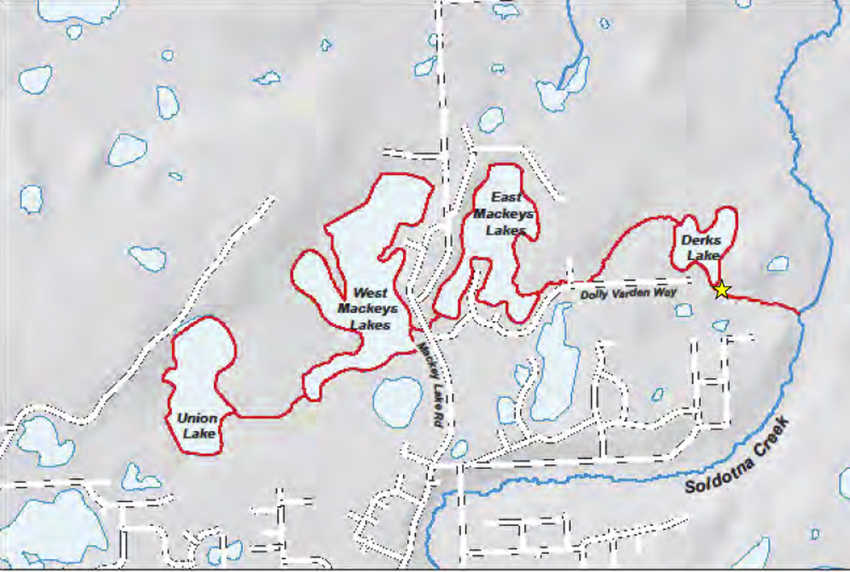It’ll take four years and more than $1 million in state and grant funds, but if the Alaska Department of Fish and Game’s recently approved plan succeeds, the Soldotna Creek Drainage should be free of invasive northern pike by 2018.
In 16 days Fish and Game staff will apply the first dose of the plant-based fish-killer rotenone in the first section of the Soldotna Creek drainage scheduled to be cleared. The area includes Union Lake, East and West Mackey Lakes and Derks Lake.
The second area to be treated includes the mainstem of Soldotna Creek, Sevena Lake and Tree Lake, which Fish and Game plans to treat in 2016 and again in 2017 after netting and removing native species of fish from the area.
The Alaska Board of Fisheries met Friday to hear the details of the plan and ultimately approved it unanimously. It is the last step in a several-year planning process that included public scoping meetings, and alternative plans to poisoning the water including fish barriers and controlled netting for pike. Both were determined to be either too expensive or impractical for eradicating the species, Fish and Game biologist Robert Massengill told Board of Fisheries members.
Fish and Game staff told board members that pike, which are indigenous to other parts of the state, were illegally introduced on the Kenai Peninsula in the mid-1970s — first to Derks Lake in the Soldotna Creek drainage. Since that time 18 other lakes on the Kenai Peninsula have had pike found in them.
Pike have decimated the fish population in Derks and the surrounding lakes, Fish and Game regional supervisor Tom Vania said.
“The lakes contain no other fish species than northern pike,” he said.
Soldotna Creek, Sevena Lake and Tree Lake still contain native fish, including Dolly Varden, steelhead, rainbow trout, lamprey, round whitefish, and four species of Pacific salmon.
Fish and Game staff plan to remove many of the native fish in 2015 prior to treating the area, move them into adjoining lakes and then use those fish to restock the area once it has been cleared of rotenone and pike.
The massive project is designed to keep pike from entering the Kenai River and its tributaries and potentially destroying the area’s rich salmon habitat — a problem the U.S. Fish and Wildlife service highlighted in its 2009-2010 video survey of the intersection of Soldotna Creek and the Kenai River when pike were recorded passing between the two.
“We’re looking at the Kenai River and we all understand the value and the impacts of the Kenai River drainage and here we’re trying to get out ahead of the problem,” Vania said.
The poison
Rotenone is a broad-spectrum piscicide, or fish killer. It is lethal to fish because it blocks their ability to use the oxygen in their bloodstream.
The plant-based poison doesn’t penetrate more than an inch into the soil and degrades quickly in the environment, said Fish and Game biologist Krissy Dunker.
There are no human health concerns at the concentrations Fish and Game would use, according to Environmental Protection Agency data.
It was commonly used in Alaska to prepare lakes for stocking in the 1960s and 1970s, and more recently as a northern pike killer. Fish and Game has completed eight projects including Arc Lake in Soldotna, Scout Lake in Sterling and Stormy Lake in Nikiski.
All but one of the treated areas has remained pike free, Dunker said. She told Board of Fisheries members that three years after Fish and Game treated Cheney Lake in Anchorage, two pike were seen and netted the following winter.
Dunker said Fish and Game staff believed those fish to have been the last of any remaining in the lake.
“We do, right now, consider the lake to be pike free,” she said.
While the chemical is widely considered to be most dangerous to the people applying it, fish and invertebrates in the water, Fish and Game staff said they would take steps to ensure no necessary exposure to the compound.
“As a precaution, particularly near Soldotna Creek, we will be testing well water,” Dunker said.
In addition, a potassium permanganate station will be in place in Soldotna Creek near its confluence with the Kenai River. The compound neutralizes the effects of rotenone.
“Caged fish will be monitored very closely downstream of the neutralization stations to ensure that rotenone is not escaping into the Kenai River,” according to the project description. “If these sentinel fish show any signs of rotenone exposure, staff operating the neutralization stations will be immediately notified to increase the amount of potassium permangenate.”
Even if small amounts of rotenone were to enter the Kenai River, it would be harmless to fish due to the water volume of the river, Vania said.
The cost
The Soldotna Creek pike eradication plan isn’t cheap.
Since 2012 Fish and Game has received more than $330,000 in grant funding from the National Fish Habitat Partnership and the Alaska Sustainable Salmon Fund to conduct public scoping, collect data in Soldotna Creek and treat the first of the lakes. Fish and Game put $113,000 in staff salaries toward the first part of the project.
Another $445,100 grant request has been submitted to the sustainable salmon fund and, if those funds are awarded, Fish and Game plans to match that grant with another $159,000 in staff salaries to complete the project.
The final cost would be more than $1.04 million — a figure some board of fisheries members were unhappy to see.
“If the person who introduced these non-indigenous fish to the system were caught, could there be restitution for this project?” asked John Jensen, board member from Petersburg. “Just adding up the numbers, this is turning into a pretty expensive project and it bothers me that somebody introduced these fish illegally and now the state has to pay for it.”
Reach Rashah McChesney at rashah.mcchesney@peninsulaclarion.com.


